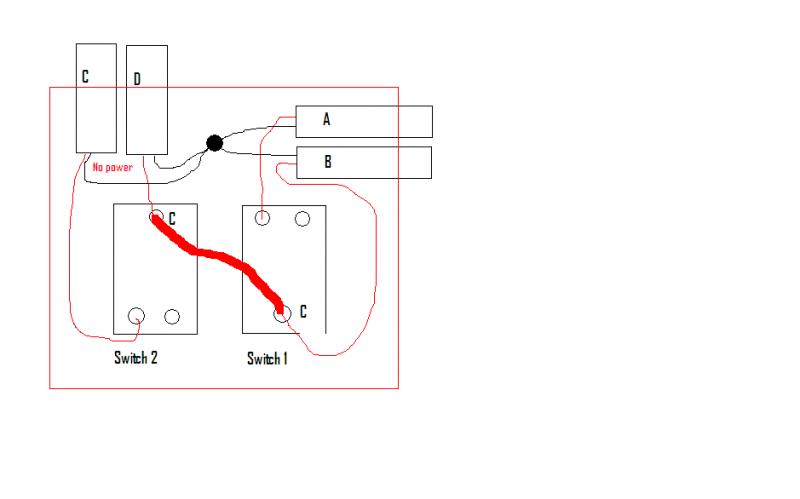Apologies if the title confuses the issue even further, but here is my situation:
My house is less than 10 years old and wiring seems to be OK. In my lounge I have a double wall switch. I also have two ceiling lights and wall plates hiding wiring for 3 wall lights. Assumption then is that one switch controls ceiling lights, one controls wall lights. Behind the double switch are 4 twin and earth cables. I will call them A, B, C and D. This also seems to fit the assumption of one pair per set of lights.
I have had two ceiling lights operating successfully from one of the (2 way) wall switches, and using one pair (A and B) of the twin and earth cables. Total load 10 bulbs x 40 W, switch rated at 450 W. All OK so far.
Now I decide to install some new wall lights. All wiring is in place behind wall plates, so connecting them up is no problem. I then connect the cables C and D to the second switch. Problem 1: with the mains back on, there is no power in either of these cables (C or D) which enter the switch box. Both dead. Of the 4 cables entering the box, power appears to be in only one red wire of cable A, which is currently supporting the working ceiling lights.
So I fitted a jumper from the Common of switch 1 to the Common of switch 2 to supply power to the C / D / switch 2 combination.
The new lights work, but Problem 2: All the lights run off switch 1. Switch 2 does nothing.
Problem 3: the whole switch wall plate is getting very hot, suggesting the new wall lights are overloading the one working switch.
Obviously I need to remedy the overheating problem quickly, but my question is was my assumption right or wrong that the two pairs of cables are for the independent wiring of two sets of lights? See my diagram below.
[/img]
My house is less than 10 years old and wiring seems to be OK. In my lounge I have a double wall switch. I also have two ceiling lights and wall plates hiding wiring for 3 wall lights. Assumption then is that one switch controls ceiling lights, one controls wall lights. Behind the double switch are 4 twin and earth cables. I will call them A, B, C and D. This also seems to fit the assumption of one pair per set of lights.
I have had two ceiling lights operating successfully from one of the (2 way) wall switches, and using one pair (A and B) of the twin and earth cables. Total load 10 bulbs x 40 W, switch rated at 450 W. All OK so far.
Now I decide to install some new wall lights. All wiring is in place behind wall plates, so connecting them up is no problem. I then connect the cables C and D to the second switch. Problem 1: with the mains back on, there is no power in either of these cables (C or D) which enter the switch box. Both dead. Of the 4 cables entering the box, power appears to be in only one red wire of cable A, which is currently supporting the working ceiling lights.
So I fitted a jumper from the Common of switch 1 to the Common of switch 2 to supply power to the C / D / switch 2 combination.
The new lights work, but Problem 2: All the lights run off switch 1. Switch 2 does nothing.
Problem 3: the whole switch wall plate is getting very hot, suggesting the new wall lights are overloading the one working switch.
Obviously I need to remedy the overheating problem quickly, but my question is was my assumption right or wrong that the two pairs of cables are for the independent wiring of two sets of lights? See my diagram below.
[/img]


